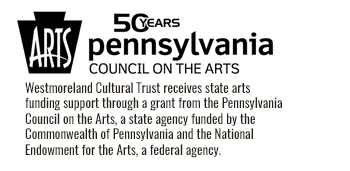Greensburg in the 1920s – as today – was Westmoreland County’s center of business and cultural activity and supported many theatres throughout the early 1900s. The biggest and most elegant of all was the Manos Theatre, constructed on the site of the smaller Rialto Theatre. Originally seating 2136, the Manos Theatre provided the community with daily doses of vaudeville, silent motion pictures and road shows, accompanied by a magnificent Wurlitzer organ. A dome of red, blue, and green lights high in the theatre’s ceiling would blink and flash to the music, similar to effects seen in today’s roller rinks.
Only venues in larger cities could match the elegance of the Manos Theatre. Its French Renaissance design boasted a golden Grecian marble balustrade and trim, elegant Vermont marble staircase, brass railings, colorful murals, black and white checkerboard tile floors, wrought copper and iron hanging baskets for flowers, and a flowing fountain with live goldfish. Below the Manos Theatre was a bowling alley, billiard parlor, and a production facility which turned out newsreels of current events to play on the theatre’s movie screen before the show. The Manos was a spectacular place to visit, and quite the place to be for superb entertainment. Lines at the Box Office on show days would often extend up the block to Main Street.
In 1927 the film industry exploded with the Warner Bros. release of the world’s first synchronized-sound feature film, “The Jazz Singer” starring Al Jolson. “Talking pictures” became the rage and in 1930 Warner Bros. Theatres, Inc. of New York assumed ownership of the Theatre from Manos Enterprises. During that era, the major film production companies owned hundreds of theatres to ensure that their films were seen throughout the country. The increasing popularity of motion pictures soon replaced vaudeville, and the industry experienced tremendous growth throughout the next decades. Scores of area natives still fondly remember spending Saturdays at the Manos, watching cartoons and movies for hours. Warner Bros. Theatres went through its own growth cycle, with a series of names changes and mergers over the years, evolving into RKO-Stanley Warner Theaters, Inc. by the early 1970s.
By 1973 film distribution had developed so significantly that theatre ownership was no longer necessary for the major motion picture companies to thrive. The Manos Theatre was sold to Cinemette Theatres, Inc. of Pittsburgh, PA. Suburban multiplex theatres, however, posed a threat and business at the Manos Theatre suffered. The theatre closed as the company opened Cinemas IV at Westmoreland Mall, and Cinemette sold the Manos in 1977 to local businessman Carl V. Marinelli and his business partner Adelaide DelVitto, and the venue was renamed The Palace Theatre. A year later, Mrs. DelVitto sold her interest in the theatre back to Mr. Marinelli.
Mr. Marinelli scheduled movies and live performances and boasted such talent as the up-and-coming Gloria Estefan & The Miami Sound Machine, Mel Tillis, Tammy Wynette, Dr. Hook and Chubby Checker. In the late 1980s, Mr. Marinelli considered selling the theatre to an out-of-state businessman who wanted to raze it. A group of culturally-minded activists rallied to save the theatre. Before arrangements were made, Mr. Marinelli passed away. City leaders, with the assistance of the Greensburg Area Cultural Council and other community leaders, worked with Mr. Marinelli’s survivors to spare the Theatre from the wrecking ball.
City Council authorized the formation of the non-profit Greensburg Garden and Civic Center Inc. to complete the sale of the Theatre in 1990. The organization was renamed The Westmoreland Trust in 1992, then Westmoreland Cultural Trust in 2005 to best identify its mission. Westmoreland Cultural Trust also manages the Greensburg Garden and Civic Center, the James/Stark building and the Union Trust building in downtown Greensburg.
Westmoreland Cultural Trust has spearheaded more than $12 million in Palace renovations since 1990, including lighting and sound systems (with an infra-red hearing-assist system), carpeting, air-conditioning, Loge and Balcony seating, restoring two murals, creating a courtyard, installing replicas of the theatre’s original opera boxes, and the construction of Megan’s Suite. The Palace Theatre now accommodates up to 1369 patrons.
In the late 1990s, renowned conservator Christine Daulton restored two of The Palace Theatre’s three original murals based on French fairy tales and painted by artist Louis Grell. Murals along each side of the Loge were covered for years with tapestry and furring strips that severely marred the paintings. The third mural is under a coat of paint spanning the area above the stage’s proscenium arch. It has not yet been determined if this top layer of paint can be removed without damaging the original painting so that a new generation can view the long-hidden masterpiece underneath.
Megan’s Suite adjacent to the outer lobby (originally featuring ice cream and candy in the Strand Sweets Shoppe) features table seating, concessions, and bar service for most performances. Dedicated in September 2004, the space was named in memory of Megan Smith, a Greensburg-Salem High School graduate who perished in a car accident at the age of 18. Megan was active in her school’s theatre productions, and her parents’ generous contribution helped to create a space for casual gatherings and formal receptions. The two-story Suite includes restrooms for men and women on both levels and an elevator to facilitate access to the Theatre’s Mezzanine, Loge and Balcony. Outside Megan’s Suite on the site of the former Strand Theatre is the landscaped courtyard, completed in 2000 through private funding and donations. Megan’s Suite and the S&T Bank Courtyard area are available for use as a conference center and may be reserved for private pre- or post-show parties.
Much of the original Manos Theatre remains intact. The golden marble ticket booth with its unique wheel of overhead lights at the theatre’s entrance is still used before performances. Keen eyes notice the pink, yellow and blue flowers on the lobby chandelier. Black and white floor tiles continue to grace the outer lobby and mezzanine. Movie projectors from the 1920s are displayed in the mezzanine area, where children once enjoyed a fountain bubbling in the Spanish-inspired mosaic tile pond of live goldfish! Through the generosity of the late Paul Jennings, the mezzanine features photos of projectionists from long ago.
Westmoreland Cultural Trust has not finished its renovation efforts. There is much yet to do, but we have come a long way since 1926. Westmoreland Cultural Trust will continue development of The Palace Theatre, both as a structure and an institution, so that it may serve future generations.
VIDEO TOURS OF THE PALACE THEATRE
Part 1: The History
Part 2: Outer Areas
Part 3: Inside the Theatre
Part 4: The Stage
Part 5: Behind the Scenes




